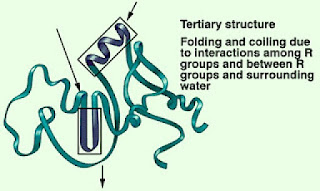Levels of protein structure
1. Primary structure
- Primary structure is structure showing the number and sequence of amino acids in its molecule.
 |
| Primary structure of insulin |
2. Secondary structure
- Secondary structure is the structure showing the coiling of polypeptides to become helix or the folding of polypeptide to become pleated-sheet.
- Secondary structures are maintained and stabilized by hydrogen bonds.
 |
| Secondary structure of protein |
3. Tertiary structure
- Tertiary structure of protein is the structures showing how a single polypeptide chain (helix) is folded form a globular structure.
- This structure is maintained by various bonds; among which are disulphide bonds, electrovalent bonds or hydrogen bonds.
 |
| Tertiary structure of protein |
4. Quaternary structure
- Quaternary structures of protein is the structure showing how two or more polypeptide chains are bound together.
- Examples of protein with quaternary structure are hemoglobin.
 |
| Quaternary structure of protein |
 |
| Four levels of protein structure |
Composition and structures of protein
1. Proteins can be classified according to its composition or structure.
2. Based on composition, proteins can be grouped into:
- simple protein
- conjugated protein
3. Based on structure, proteins can be divided into:
- Fibrous protein
- globular protein
Simple protein
- Proteins that contain amino acids only.
- For examples: albumin, globulin, and histone.
Conjugated protein
- Protein bounds to non-protein groups.
- Non-protein groups which bound to proteins are known as prosthetic groups.
- For example: hemoglobin.
 |
| Structure of hemoglobin |
Fibrous protein
(a) Fibrous protein consists of long and parallel polypeptide chains.
(b) The polypeptide chain in fibrous protein is usually coiled to form α-helix.
(c) Neighboring helical chains are usually cross-linked by hydrogen bonds, electrovalent bonds, or disulphide bonds.
(d) Fibrous protein are not soluble in water and are very strong.
(e) Examples of fibrous protein:
- Collagen - in tendons, cartilages, bones and skin.
- Myosin - structural protein in muscles.
- Keratin - structural protein in hairs, nails, feathers and horns.
- Elastin - found in ligaments.
- Sclerotin - combines with chitin to form the exoskeleton of insects.
(f) Collagen is the most common protein in mammals.
- This protein is a main structural component of connective tissues (cartilage, skin, tendons and ligaments).
- The basic structure of collagen is a tropocollagen helix which consists of three polypeptide chains (helixes) twisted together.
- The chains are stabilized by hydrogen bonds between the protein chains.
 |
| Collagen fiber |
Globular protein
(a) In globular proteins, the polypeptides (helixes) are folded into globular structures.
(b) The globular structure is maintained and stabilized by hydrogen bonds, disulphide bonds and electrovalent bonds.
(c) Some globular proteins are soluble in water; some of them form suspension, and the rest are insoluble in water.
(d) Globular proteins are easily denatured. This is because the hydrogen bonds and disulphide bond in the molecule can easily be broken.
 |
| Denaturation of protein |
(e) Examples of globular protein:
- Hemoglobin
- Myoglobin
- Hormones
- Enzymes
No comments:
Post a Comment